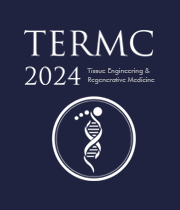Title : Remote activation of mechanotransduction via integrin alpha-5 by aptamer conjugated magnetic nanoparticles promotes osteogenesis
Abstract:
Introduction
Magnetic particle (MNP) based technology platforms use superparamagnetic nanoparticles conjugated with targeting biomolecules to apply mechanical force directly to mechano-receptors on the cell surface, stimulating mechanotransduction and downstream signalling [1]. This technique has been reported to promote differentiation toward musculoskeletal cell types from adult stem cells from multiple sources [1,2]. Aptamers are short nucleic acid sequences capable of specific, high-affinity molecular binding which bind to proteins and receptors with a higher affinity compared to antibodies. Aptamers have several advantages, including small size, good biocompatibility, and low immunogenicity [1,3]. In this presentation, we compare the agonists for binding to mechanoreceptors using MNP-platforms.
Methods
The MNPs were conjugated with Cd49e antibody (Thermo Fisher) for binding to the integrin α5, and aptamer (Aptamer Science) for binding to the integrin α5β1 receptors. We compared the impact of mechano-activation of receptors on the Wnt signalling pathway and osteogenesis via the conjugated magnetic nanoparticle stimulation and magnetic field. To explore the potential variation in aptamer binding and antibody strategies, antibody and aptamers were conjugated to MNPs and their signalling efficacy was investigated using Y201 TCF/LEF GFP reporter cells. Moreover, we optimized the aptamer concentration for the selected receptor to determine the optimum concentration for promoting bone formation. The concentration of binding sites on the surface of the MNP was explored using a dose-response of the aptamer and analysed by gene expression of RUNX2, evaluation of alkaline phosphatase (ALP) activity, and expression of osteopontin. Furthermore, Alizarin Red staining was conducted to evaluate the matrix mineralization.
Results & Discussion
The genetic responses of cells mechano-activated by the conjugated MNPs were studied by using TCF/LEF reporter cell line and gene expression of RUNX2 in human mesenchymal stem cells (MSCs). Analysis of data from the reporter cell line demonstrated that mechano-activation of the cells by MNPs conjugated with aptamer resulted in significant upregulation of the Wnt signaling pathway relative to the activation of the cells by MNPs conjugated with the antibody. Furthermore, the mechano-activation of MSCs by the MNP-aptamers significantly upregulated the expression of RUNX2 compared to the mechano-activation of MSCs by the MNP-antibodies that can improve osteogenesis. In addition, our findings indicate a concentration-dependent response in ALP activity, with significantly higher levels observed in cells tagged with a lower amount of the aptamer compared to those tagged with a higher amount. This trend was consistently reflected in alizarin red staining results, as well as the expression levels of osteopontin and RUNX2.that showed a lower concentration of aptamer added to the MNP can be more functional in activating the cells for long period for osteogenic differentiation and orthopaedic applications.
Conclusion
In this study, we compared the mechano-activation of cells via MNPs conjugated with CD49e antibodies and aptamers which can bind to integrins. The data demonstrated that mechano-activation of cells by MNP-aptamers significantly enhances upregulation of the RUNX2 and LEF1 genes compared to using MNP-antibodies which can potentially promote bone regeneration. Finally, our results showed that the concentration of aptamer loaded onto MNPs strongly influenced the mechano-activation of cells. These findings provide valuable insights into the use of MNP platforms for bone regeneration and highlight the potential of aptamers in promoting signaling pathways related to bone formation.


